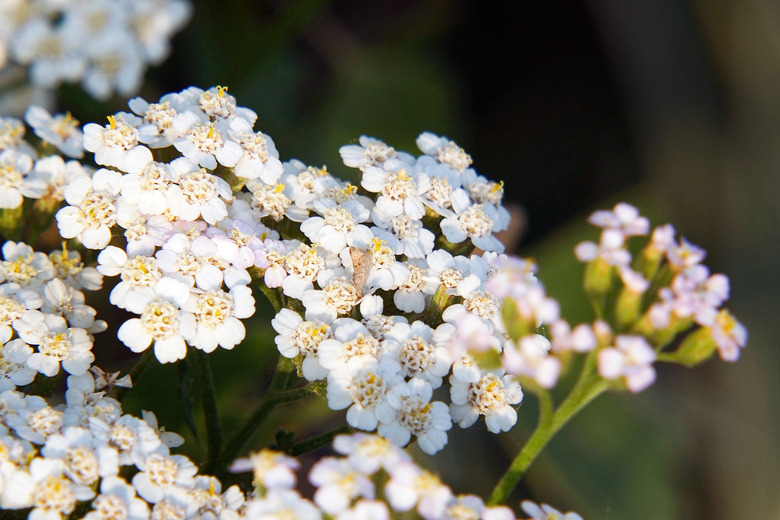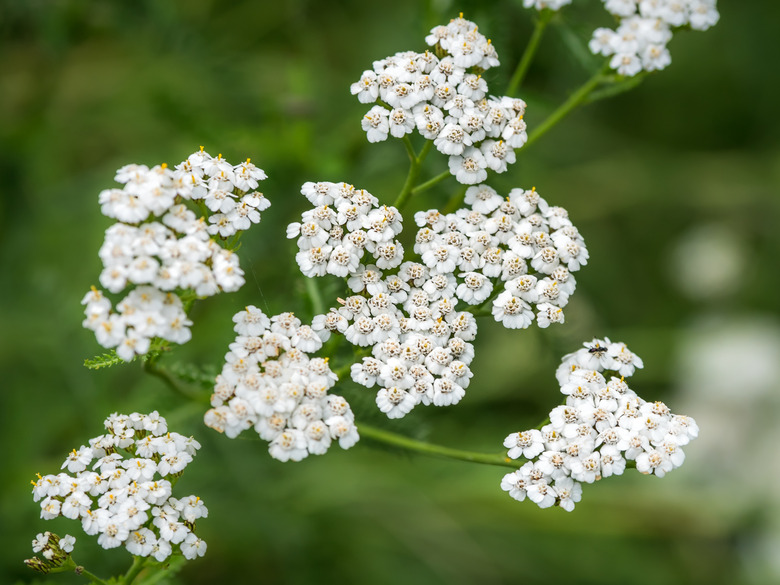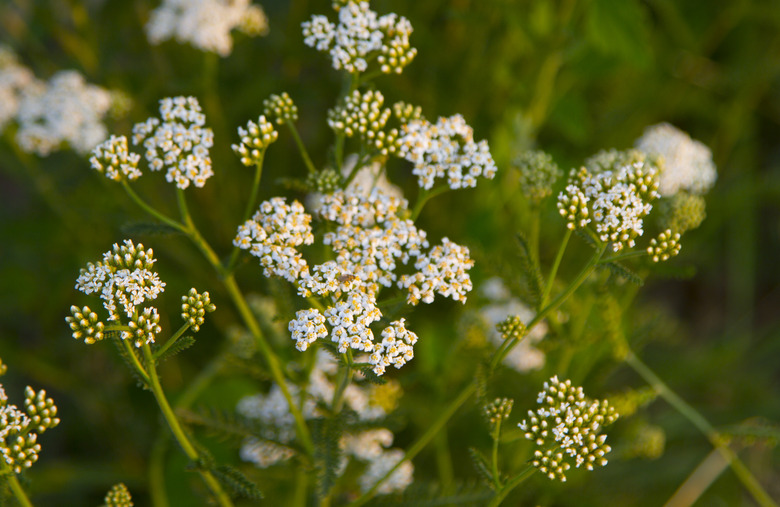How To Grow Yarrow
We may receive a commission on purchases made from links.
Yarrow (Achillea spp.) is a flowering perennial that's easy to grow and maintain year after year. One species, Achillea millefolium (USDA zones 3-9), is now considered a North American native perennial because it has widely naturalized in the U.S. since it was introduced from Europe during colonial times. It's a popular choice for borders and meadows but can also be grown in your garden. Yarrow is a showy plant producing umbels of tiny, tight-packed flowers that attract pollinators and last a long time. It's also pest-resistant, drought-tolerant, and a magnet for butterflies.
Best Uses for Yarrow
Best Uses for Yarrow
Yarrow is an attractive and easy-care herbaceous perennial. Its large flower heads are flat or umbrella-shaped and sit above the foliage, each one composed of many small, tightly packed blossoms in bright shades of yellow, pink, red, or white. Blossoms last from early summer through fall and are great as cut flowers or dried bouquets. The foliage is also interesting and is textured like fern foliage. In fact, those living in the Southwest often use another common name for the plant: "plumajillo," meaning "little feather" in Spanish.
This native plant grows knee high or taller, generally growing between 12 and 36 inches tall with a similar spread. It works well in borders, the back of sunny garden beds and in any landscaping space that's dedicated as a prairie, meadow or naturalized area. Yarrow would be appropriate in a perennial garden, an herb garden or a cottage garden. Given the plant's drought tolerance, yarrow would also be appropriate for xeriscaping in hot, dry environments.
Some gardeners grow yarrow as an aromatic herb. Those using herbs for medicine say that it has many healing properties. The leaves and flowers are used to combat diarrhea and gas. They are also used for asthma, colds, runny nose and the healing of skin conditions or wounds. There have not been many scientific studies to confirm or reject these claims, but yarrow's medicinal use is hardly new. It has gone on for centuries. According to legend, Achilles of Troy used yarrow to treat his wounded soldiers.
How to Start Yarrow From Seed
How to Start Yarrow From Seed
It's quite common to grow yarrow from seed. This gives you the chance to try different cultivars without spending much money by purchasing seed packets. Select the seeds early so you can start them indoors some six to eight weeks before the average or projected date of the final spring frost.
To sow the seeds, use seedling pots and fill them with regular potting mix or seed-starting mix. Moisten the medium before you sow the seeds. Scatter the seeds on the top of the soil and then press them in very lightly. Sowing them deeply will probably prevent them from germinating.
These are not seeds that sprout immediately. They should germinate some two to three weeks after sowing as long as you keep the pots where it is warm and sunny. Covering the top of the plant pots with plastic wrap helps retain both heat and moisture, but take off the plastic once you see sprouts. Thin them out when they are a few inches tall, moving the strongest ones to bigger pots.
When the last frost date is behind you, it's time to transplant these young yarrow seedlings to the garden. Space the plants 1 to 2 feet apart to give them room to establish. Water the soil well immediately after transplanting and keep it moist until the plants' roots are well-established. Once mature, yarrow is drought tolerant and only requires about an inch of rainfall or irrigation a week to keep the plants looking their best during the growing season.
In What Zone Does Yarrow Grow Best?
In What Zone Does Yarrow Grow Best?
Yarrow is a perennial that grows best in U.S. Department of Agriculture plant hardiness zones 3 through 9. Because this native plant is tough, if you really want to grow it in zones 2 or 10, go ahead and give it a try. In the colder regions of its hardiness range, use plenty of mulch over the winter to help the plants make it through the cold. In zone 10, plant yarrow where it gets shade in the hottest afternoon hours.
When Should You Plant Yarrow?
When Should You Plant Yarrow?
The best time to plant yarrow is in the spring or early summer. This is true even if you buy seedlings from the garden store or root yarrow cuttings, so wait until the final frost date of springtime has passed. The last thing you want is a newly transplanted yarrow to face a frost before its root system is strong and established.
Soil, Sunlight and Water Recommendations for Yarrow
Soil, Sunlight and Water Recommendations for Yarrow
When it comes to soil, yarrow needs excellent drainage. This is not just a preference; it's a requirement. Yarrow will not thrive and may quickly die on wet soil. Sandy soil, loam or even clay will do just fine as long as it offers good drainage. The soil doesn't need to be fertile. This native herb doesn't turn up its nose at regular or even poor garden soils. Given the potential for invasive growth of yarrow, it is probably best not to fertilize. In fact, avoid soils that are too nutrient-rich since this might encourage aggressive growth.
Sun exposure is easy: Yarrow likes direct sun, at least six hours a day. If you pick a spot with less sun, your plants will be leggy and much less attractive. The only possible exception is if you try to plant yarrow in zone 10, where you can grow it on a site that gets a little shade in the heat of the day.
Irrigation is optional for yarrow once it gets established. Like every plant, yarrow needs moist soil when the seeds are germinating and significant water for seedlings as they are developing their roots. Once the yarrow plants are mature, they are drought-tolerant survivor plants. Still, for the best flowers and the happiest plants, see to it that the plants get an inch of rainfall every week during the growing season.
How to Propagate Yarrow
How to Propagate Yarrow
If you have yarrow in your yard or have a friend or neighbor willing to share, you can get new yarrow plants by taking tip cuttings and rooting them. The optimal time to do this is late spring so that you can transplant the rooted cuttings in summer. Select new shoots that are healthy and have at least four buds. Take 6-inch cuttings, snipping them off with sharp pruning shears.
Take the leaves off the lower 2 inches of each cutting. Dip the cut end into rooting hormone. Gently press each one in moist, well-draining potting mix, and then place the pots in a warm area, out of direct sun until they form roots. The soil should be moist at all times. After about three weeks, check for roots by pulling the plant gently and feeling for resistance. When roots are established, the cuttings are ready for transplant.
There is another way to propagate yarrow. This is by division, which is accomplished by removing the plant from the soil and dividing it into clumps. Yarrow plants need to be divided every three years or so to keep them growing vigorously. Using a shovel, dig up the plant's entire root ball. Prune out dead stems from the clump and then cut it in pieces and select a section with two or three stems. Using a sharp garden knife, cut down through the thick rhizomes. Replant the divisions in other sunny locations around the garden.
How to Winterize Yarrow
How to Winterize Yarrow
Yarrow grows as a perennial in USDA zones 3 through 9, where it's semievergreen in the warmest climates, holding onto some leaves during the winter. However, in most zones, it dies back in autumn. You can remove each flower stalk as it begins to dry out in order to prevent self-seeding, or you can leave the dried stalks and flowers all winter long so the dropped seeds will germinate in spring. They provide some interest during the snowy months and can offer wildlife some habitat.
Common Pests and Other Problems for Yarrow
Common Pests and Other Problems for Yarrow
High winds can flatten yarrow, especially if the plants have been allowed to grow without trimming. Combat this by planting yarrow in a wind-protected area and cutting it back several times over the course of the growing season. Pruning during the growing season helps keep the plant compact.
Soil that is too rich isn't good for your yarrow plants. They grow just fine in poor or normal soil, so don't be too generous with the compost or fertilizer. This can result in super-tall plants that flop over and require regular staking, or it can cause them to grow and spread aggressively into other beds. Just give your plants a little compost in the spring and then leave them alone.
Aphids will suck plant juices out of many different types of plants, and this includes yarrow. Aphids are small, soft-bodied insects with mouthparts that allow them to pierce the foliage and suck the sap or juices from the leaves. A few aphids won't take out a tough yarrow plant, but aphids tend to like company. If you see an infestation, you need to take some action. Try blasting them off the leaves with a strong hose.
Common Diseases for Yarrow
Common Diseases for Yarrow
Powdery mildew is a fungal disease that is pretty easy to recognize. The disease presents as a white growth on the leaves, looking a little bit like spilled powder or flour. Like many fungal diseases, it is most frequently seen in hot weather and spreads if you spray water on the leaves, allowing the fungal spores to grow and move to other leaves. Prevent this disease by thinning and pruning the yarrow to allow room for air to circulate between the plants.
Rust is another fungal disease that infects yarrow plants. Like powdery mildew, rust forms white growths on the underside of the leaves, but it looks more like large, raised freckles than powder. Over time, the white fungal spots turn into reddish-orange (rust-colored) spores and eventually become black. If the infestation is serious, leaves can drop from the plants. Use copper sprays or sulfur powders to fight this fungal disease.


